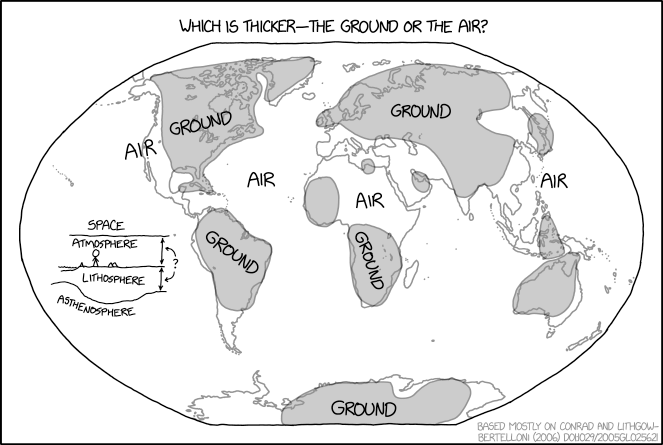Ground vs Air

Water is thinner than both, and fire is *definitely* thicker.

Water is thinner than both, and fire is *definitely* thicker.
This comic depicts a map of the world using the Winkel tripel projection, comparing the thickness of the ground, which is defined as the lithosphere, to the "thickness" (or height) of the air above it, which refers to the atmosphere.
In an inserted figure, Randall defines the thickness using three boundaries. At the top is space, defined by the Kármán line at an altitude of 100 km (≈ 62 mi). (See the Trivia section below for a discussion of this definition of the beginning of space.) Below that is the atmosphere which goes down to the ground, where Cueball is standing, or the water. Beneath the surface is the lithosphere, comprising the Earth's crust along with the rigid upper part of the mantle, and beneath this is the asthenosphere, the partially melted, highly viscous region of the upper mantle just below the lithosphere. The lithosphere is variable in thickness, averaging about 100 km, but the oceanic lithosphere is much thinner than the continental lithosphere (oceanic crust is thinner and denser than continental crust). The diagram also shows oceanic cross-section to the left-hand side and, though the diagram does not make it explicit, presumably the two measurements used are of the atmosphere down from 'space' to the surface of the ground, if dry, or to the surface of the water covering the ground (which is essentially sea level in the oceans, fluctuating slightly with the tides, but covers a broader range for inland water, from the Dead Sea, at 0.4 km below sea level, to Lake Titicaca, almost 4 km above sea level) and of rock descending from the solid interface down to the asthenosphere, as the sliver of liquid that can intervene between the two spans is referred to as a separate measurement elsewhere.
The map shades in the parts where the thickness of the ground is thicker than the thickness of the air. This almost only occurs directly over continents, and certainly only where the continental crust is located (which can stretch into the near-coast parts of oceans). Oceanic crust is much thinner than continental crust. It is also made of a different material; it is denser. Because it is denser, it floats lower in the liquid asthenosphere, causing it to be below sea level. Some parts of continental crust are also under sea level (the continental shelf). These are the areas on the map that are marked as having thicker ground that appear to be over the ocean (such as Northern Canada, or the Caribbean) - they are actually still continental crust. (There are still some exceptions, such as the Sea of Japan and the Philippines).
Randall has mainly used a work by Conrad and Lithgow-Bertelloni from 2006 to estimate the thickness of the "ground", and he gives the reference to the paper DOI.1029/2005GL025621. Basically, Randall has taken their map and shaded the green and blue areas. It is the second comic in a row with a citation, after the footnote in 2241: Brussels Sprouts Mandela Effect.
The title text refers to the ancient four classical elements: earth, water, air, fire. The lithosphere, or ground, is earth, the oceans is water, the atmosphere is air, and fire would thus be the hot, plastic rock of the Earth's mantle, see 913: Core. The mantle is not "on fire", but it is hot enough that it would ignite almost anything on the surface. The water layer on Earth is never more than 11 km deep, even at the deepest part of the ocean, the Mariana Trench, and thus cannot compare to the thickness of the atmosphere or the lithosphere. An expansive definition of "fire" to include the rest of the Earth below the lithosphere puts the fire layer at 6,000 km thick, the radius of the Earth, much thicker than the other layers, hence the and fire is *definitely* thicker comment at the end of the title text. Space or vacuum would in the classical element terminology have been called the Aether.
In 977: Map Projections the Winkel-Tripel projection is the fifth projection which is linked to the hipster subculture.